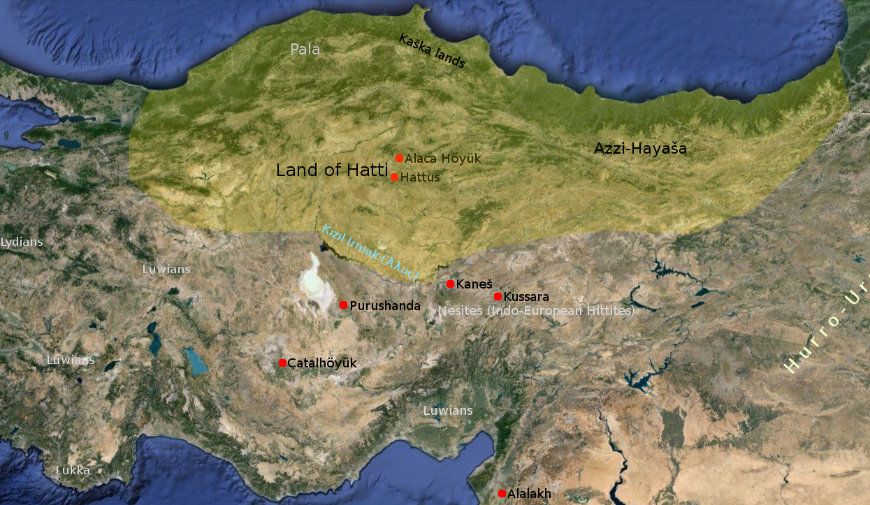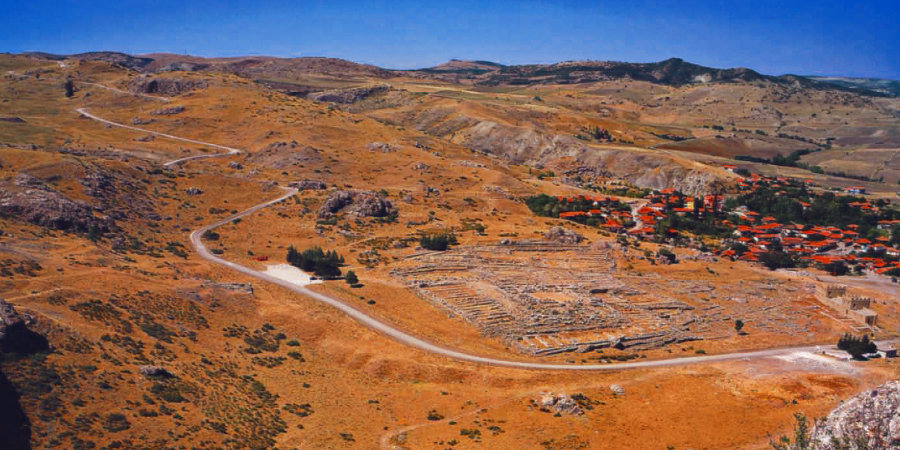The Hattians and the Hattic language
The Hattians and the Hattic language
Four thousand three hundred (4300) years ago, the Akkadian army of king Naram-Sin marches towards the Anatolian plateau. Pamba king of the Hatti, Zipani king of Kanesh, Tisbinki king of Kussara, Nur-Dagan king of Purushanda and thirteen more kings from the Hatti lands unite against Akkadian ruleF.C. Woudhuizen (2010). Those are the HattiansWhether all of the 17 kingdoms had an ethnically Hattian population or not, cannot be established., the indigenous people of Asia Minor, mentioned for the first time in historyT. Bryce (2009), I. Singer (2007), A. Calderone (2000), G.L. Kavtaradze (2002), B.J. Collins (2007) Hattians are often referred to as the indigenous people of Anatolia, but the only thing certain is that they were already present before the arrival of the Anatolian Indo-Europeans.. Their history apart from the Hittite empire is short lived and not well documented. Around 2700 B.C. the trading routes between the Hatti lands and Mesopotamia had been established. By 2500 B.C, Hattuš was a well fortified city and power center of the Hattian civilization. Around 2330 B.C, Sargon of Akkad, Naram-Sin's grandfather, invaded the Hatti lands, but Hattuš was too strong to fall.Ethnogeography of central Anatolia: Hattic, Nesite and Luwian
Although the earliest Kingdoms had a native Anatolian character, it is generally difficult to confidently identify the predominant ethnic character of the populations who inhabited bronze age Anatolia. The ethnocultural zones are only distinguishable by their onomasticon and pantheon. The material culture is an indicator, but during the bronze age it is locally made, not imported. We do not know when the Indo-Europeans first appeared, whether a century, a millennium, or several millennia before their first attested appearance in written records. For instance, it is not clear whether the occupants of the Alaca Höyuk tombs are Hattians or Nesites (Indo-European Hittites), as this is at the moment a matter of faith rather than archaeology. Archaeology has not provided us with any conclusive evidence as to the date of an Indo-European arrival. However, the earliest identifiable occupants of north-central Anatolia are Hattians. They are believed to have inhabited the Kızıl Irmak (Ἅλυς/halys) basin in north-central Anatolia, including towns such as Hattus and Zalpa, while the Indo-European Nesites were centred to their south in Cappadocia in the vicinity of Kanes and KussaraT. Bryce (2009).
The Kaškaeans who appear in records of the later times are considered as one of the ethnical remnants of the Hattian population which was pushed northward by the HittitesSinger (1981). In the same region, ancient authors mention the people called Chalybes, the famous iron smelters, whose name may very well derive from the Hattic word for iron “ḫapalki” (Hurrian ḫabalgi, Greek χάλυψ “steel”). The Azzi-Hayaša confederation seems to be predominantly Hattian too, which means that there must have been a continuous Hattian belt along the southern coastline of the Black SeaSinger (2007).
The Hattic language
In order to demonstrate how little we know about the Hattian language, it's enough to mention the following numbers: There are around 360 Hattian fragments available to us, of which only 15 are Hittite-Hattic billingualsP. Goedegebuure (2010). The situation is desperate, but we do know relatively much thanks to the efforts of certain scholars. Approximately 300 wordsThe exact number depends on how one counts: Words we do understand or words we want to believe we understand. See Kashian (2010) for what is included in those 300 lexical items. are available to us, but not all of them have a well-established meaning. Whatever was left to us, is through cultic Hittite texts, where the chanting is switched to “Hattili”, meaning in the language of Hatti.The position of Hattic
Based on how little we know, Hattic should practically be considered as an isolate. However, there are many attempts to relate it to Northwest Caucasian languages (Abkhaz, Adyghe, Kabardian, Ubykh) Forrer (1919), Dunaevskaja (1960), Diakonoff (1990), Braun (1994), Chirikba (1996) and some to KartvelianSee Girbal (1986) and Gabeskiria (1998). It is generally not a widely accepted view.. The classical view of a connection between the pre-Greek substratum language and Anatolia might now echo in Hattic (instead of Luwian), since a possible western relative has not escaped attentionForrer (1938), E. Brown (1974), Schrijver (2007, 2011), Kroonen (2012), G. Tardivo (ongoing).Characteristics and grammar
Hattic was an ergative, agglutinative language with weakly developed suffixation but heavy prefixationThe reverse is true for Hurro-Urartian. Verbs contained a string of prefixes with fixed order, expressing different grammatical relations. The verbal roots were predominantly monosyllabic or disyllabic. The verbal forms could express at least two grammatical persons by means of personal prefixes.Prefixes
| Prefix type | Prefix | Examples |
|---|---|---|
| Personal |
a- 3rd person singular, object and subject (a)n-/m- 3rd person singular, subject - before a labial the n changes to m. eš/aš/uš 1st person plural wa- 2nd person singular |
a-ta-niwāš = he-inside-is sitting a-n-taḫa = it-he-inside-put uš-ḫa-aš = we ourselves |
| Possesive |
le- = one or several objects in possession te- = for one possessor (his, her) that has one object in possession še- = several possessors or several objects of possesion |
pinu 'child' le-pinu 'his children' wēl 'house' le-wēl 'his houses' karam 'libation' te-karam 'of his libation' alep 'language' še-alep 'their language' |
| Plural | wā- (wi- for indefinite) |
šḫap 'god' wā-šḫap 'gods' wēl 'house' wā-wēl 'houses' |
| Directional |
ka- 'hither', 'on', 'over' a-kka 'upwards' |
ka-ur(a)n-ti-u = stands over the well a-kka-tuḫ = upwards he took |
| Locational |
ta/tu- 'in', 'inside' ḫa- 'among', 'between', 'into' li-/zi locative prefix before the enclitical pronoun 'from', 'at' pe/pi- 'into' |
a-ta-niwāš = he-inside-is sitting ḫa-wā-šḫap = amongst the gods zi-jaḫ-du = from the sky thither taš-te-nuwa pe-wēl = not-let-go into-house |
Suffixes
| Suffix type | Suffix | Examples |
|---|---|---|
| adjective forming | -ḫ |
tittaḫ 'big', 'great' ašaḫ 'evil' |
| feminine | -aḫ | katte 'king' vs kattaḫ 'queen' |
| definite | -ma | šāwat 'apple' in the sentence šāwat-ma ka-ur-(a)n-ti-u 'apple stands over the well' |
| past tense forming | -an | a-an-ta-ḫa-an 'he has put' |
| dative | -ja |
katte-ja 'to the king' ta-ja-ja 'let-give-to him' |
| genetive | -Vn | zari 'man' → zari-un 'of man' |
| ablative | -tu/-du |
This suffix answers the question from where?
wūr-tu 'from the land' |
| agent, possession or origin |
-Vl (masculine) -iti (feminine) |
takkeḫa 'lion' → takkeḫal 'hero' Nerik + il 'person from Nerik' Hatti + li 'in the Hatti language' (Hittite) Hattus + ilis → 'man from Hattusa' Arinna + iti → Arinn-iti 'she from Arinna' |
| locative | -š | ḫattuš place of Hattussa |
Phonology
The writing system does not allow us so far to make a judgement about the phonological contrasts which existed in this language. Any attempt to establish a detailed Hattian phonology is rather hazardous.Hattic and Luwian
The Hattian language structure was profoundly influenced in pre-historic times by proto-LuwianGoedegebuure (2008). This pre-historic language contact resulted the rapid language swift for Luwic speakers of the Hatti region. In turn the true substrate influence of Hattic in Hittite is overestimated. Half of the substrate words are in fact Luwian e.g. Labarna, TawannannaKlinger (1996), Stefanini (2002), Melchert (2003).Hattic, Nesili (Hittite) and the Indo-European migrations
In the second millennium B.C, the Hittite empire established the Indo-European Nešili language as the official language of the stateSteadman (2011). The native populations continued to speak their language, but that did not last long into the late second millennium B.C. The rapid language shift could be due to sociopolitical reasonsThat means that the language was either imposed by force or it was in the interest of the natives to adopt Nešili as their main language. or simply the first attestations of Hattic are in a point in time when the language was already decaying. The total period of coexistence between Hattic and the Indo-European languages of Anatolia is unknown, because there is no archaeological evidence of an Indo-European entry to AnatoliaSteadman (2011). Based on linguistic evidence combined with few archaeological traces, it is estimated that the Indo-European proto-Anatolian speakers, entered Anatolia in the fifth or possibly early fourth millennium B.CD. Antony (2007).Sample Glossary
| Hattic | Meaning | Comments |
|---|---|---|
| -anna | woman |
Hittite anna “mother” Proto W.Caucasian *(a)nƏ “mother, female” |
| katte | king |
Carian (Kaunian) kδouś “king” Common Abkhaz *qada “chief'” |
| kuka | ancestor | (Pre-)Greek κοκύαι “ancestors”, Lycian χuga “grandfather'”, Luwian huha “grandfather'” |
| pinu | son | Common Abkhazian *pa “son, child” |
| psun | breathing, soul |
(Pre-)Greek φυσᾶν “puff”, “to blow” Greek πνοή “breath”, πνεῦμα “spirit, soul”, ψυχή/φσυχή “soul” Armenian p'uk “puff of air” |
| šaḫiš | kind of tree |
Hittite šaḫi- “wood material” Ubykh sƏχƏ “wooden bolt, pole” |
| sḫap | god |
Ubykh wašχa “thunder and lightning” Greek personal name Σαπφώ “numinous”(?) |
| titt- | great, big |
(pre-)Greek τιτάν “giant, a deity of enormous size” Common Circassian emphatic particle *dada |
| zari | mortal, man | Linear A sa-rja 'person' (?), often corresponding an ideogram for people |
| zinar | musical instrument | Armenian ӡnar “lyre, harp” |
Sample Text
Hattic: ašaḫ tas-te-nuwa pe-wēlEnglish (direct): evil (one) not-let-come in-house
English (normalized): Don't let the evil one to come inside the house
Hattic: kattaḫ te-p-kunku-hu-a
English (normalized): Long live the Queen!
Hattic: wa-šḫap-un wa-zari-un wa-ašaḫ alep
English (direct): PLUR-god-OBL PLUR-human-OBL PLUR-bad tongue/word
English (normalized): the bad words of the gods and humans
The Hattian pantheon
| Deity | Function | Comments |
|---|---|---|
| Wurunšemu/Eštan/Arinniti | Sun-goddess and mother of the earth | Equivalent to the Hurrian deity Hepat |
| Taru | Storm/weather god | The IE-Anatolian Tarḫunt(as) / Hurrian Tešub |
| Telipinu | God of farming | His name means sublime/great son (of the Storm god) |
| Kašku | Moon god | Equivalent to the Hurrian Kušuh |
| Inara | Protector deity | |
| Istustaya & Papaya | Deities deciding the fate of every mortal by spinning a thread | Equivalent to the Greek Moires |
| Kataḫziwuri | Earth/Land god | |
| Ḫalmaššuit | Local deity, Oracular deity (?) | |
| Ḫantapali | Oath deity | |
| Ḫašammil | Protector of homes and children, god of smiths | Equivalent of Greek Kasmilos |
| Ḫašgala | Tutelary Deity | |
| Lelwani | Deity of the underworld | Identified as the Mesopotamian Ereshkigal |
| Kakšazet | ? | |
| Kaštuwarit | ? | |
| Taḫakšaziatiš | ? | |
| Tuḫuleli | ? | |
| Zitḫariya | Oath deity | |
| Zuliya | ? |
Gallery
Tags: Hattic, Hattians, Hatti, Hittites, Kaska, Azzi-Hayaša, Anatolia, Asia Minor, Turkey, Black Sea, Caucasus, Aegean, Abkhaz, Ubykh, Hurrian, Pre-Greek, Minoan







